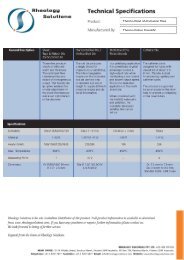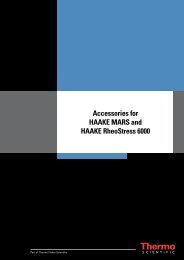Download - Rheology Solutions
Download - Rheology Solutions
Download - Rheology Solutions
You also want an ePaper? Increase the reach of your titles
YUMPU automatically turns print PDFs into web optimized ePapers that Google loves.
• application notes & technical articles<br />
The influence of thickeners on the application<br />
method of automotive coatings and paper<br />
coatings – rheological investigations<br />
surface coatings industries<br />
Spraying automotive coatings<br />
and the application of paper<br />
coatings are industrial<br />
processes, in which<br />
elongational flows play an<br />
important role.<br />
As a result, the application behaviour of these<br />
fluids often cannot be sufficiently characterised<br />
with traditional shear experiments. Products with<br />
similar shear viscosities can have very different<br />
elongation properties.<br />
With the Thermo Scientific HAAKE CaBER 1<br />
extensional rheometer, a liquid filament is created<br />
that is stretched under the influence of surface<br />
tension. Using the decrease in the filament<br />
diameter as a function of time and the life of the<br />
filament, it is possible to characterise the<br />
elongational behaviour of low viscosity to pasty<br />
liquids in a simple way. The rheological properties<br />
of typical water-based automotive coatings and<br />
paper coatings are determined by the thickeners<br />
used and their interactions with the other recipe<br />
components. In the CaBER 1 experiment, different<br />
types of thickener display a characteristic<br />
decrease in the filament diameter as a function<br />
of time. Different break-up times are desirable,<br />
depending on the application.<br />
When automotive coatings are sprayed, short<br />
break-up times are advantageous in order to<br />
obtain the finest possible drop distribution.<br />
When paper coatings are applied with rollers,<br />
spraying and „misting“ should be prevented as<br />
much as possible, which means that formulations<br />
with long break-up times are advantageous.<br />
A full copy of the application note is available on<br />
request by quoting V-206.<br />
• application notes & technical articles<br />
Slurry rheology and pipeline transport<br />
properties, an overview<br />
surface coatings industries<br />
Slurry transport in the mining<br />
industry is a commonly used<br />
technique for moving partially<br />
and fully processed materials,<br />
and waste.<br />
Often this type of treatment is more economical<br />
and rapid than other transportation methods, such<br />
as those involving conveyor systems or haulage.<br />
Additionally, the materials on a mine-site are often<br />
slurried for processing, and pipeline transport is<br />
necessary.<br />
However frequently utilised, efficient slurry<br />
transport still poses serious engineering problems<br />
through the properties of the slurry. These<br />
include, but are not limited to, particle settling,<br />
attrition, pipe/fitting/impeller wear, degradation of<br />
flocculated or friable solids, and the pumpability of<br />
the slurry. In addition, the effects of these<br />
challenges can be exacerbated, or reduced by<br />
biennial 07-08<br />
process or environmental variables, such as<br />
temperature, pH or solids loading.<br />
In-transit particle settling leads to stratified flow,<br />
which in turn can cause uneven and excessive<br />
wear in the transport system, and in extreme<br />
cases, pipeline blockage due to solids build-up<br />
around fittings or inclined sections. Particle<br />
attrition has several drawbacks. Firstly, the<br />
product before the pump and pipe is not identical<br />
to that afterwards if the particles are friable, this<br />
may be a QC matter both for disposal and<br />
in-process. Secondly, changes in particle size<br />
distribution may affect the ability of the particles to<br />
remain suspended in the carrier fluid. Problems<br />
with the pumpability of slurries potentially include<br />
the fact that they often behave as a solid, e.g.<br />
when at rest, making it expensive to initiate<br />
pumping. Many fluids, including slurries have flow<br />
properties which depend on the ‘rate of deformation’<br />
(analogous to their flow-rate).<br />
Rheological techniques can help the engineer or<br />
technician to design for and manipulate<br />
processes. A range of instruments is available<br />
which measure the effects of solids loading,<br />
carrier fluid, particle size distribution and viscosity<br />
or pH modifiers on the propensity of particulate<br />
matter to flocculate, be suspended, settle etc.<br />
through a knowledge of the characteristic flow<br />
properties of the slurry. These rheometers and<br />
viscometers allow the engineer to directly measure<br />
and assess the causes and effects listed above.<br />
Physical quantities such as yield stress (the<br />
minimum force required for a slurry to flow),<br />
plastic viscosity (how ‘runny’ a slurry will be at a<br />
given laminar flow-rate), hysteresis (the changes<br />
in plastic viscosity and/or yield stress which are<br />
due, usually, to particle attrition or settling) can be<br />
better predicted with the appropriate equipment.<br />
Sensitive, high precision versatile equipment is<br />
available for repeatable and reliable measurement<br />
of all flow properties in the laboratory, and durable,<br />
precise, robust units for in the field use are also<br />
commercially available. These units have been<br />
shown to be of value for both QC and product<br />
development.<br />
A full copy of the application note is available on<br />
request by quoting Rheo013<br />
22 www.rheologysolutions.com










